Shree Jagannath Temple Hyderabad
The Jagannath Temple in Hyderabad is a modern Hindu temple dedicated to the God Jagannath, which means “Lord of the Universe.” Built in 2009 by the Odia community of Hyderabad, the temple is a replica of the original Jagannath Temple in Puri, Odisha.
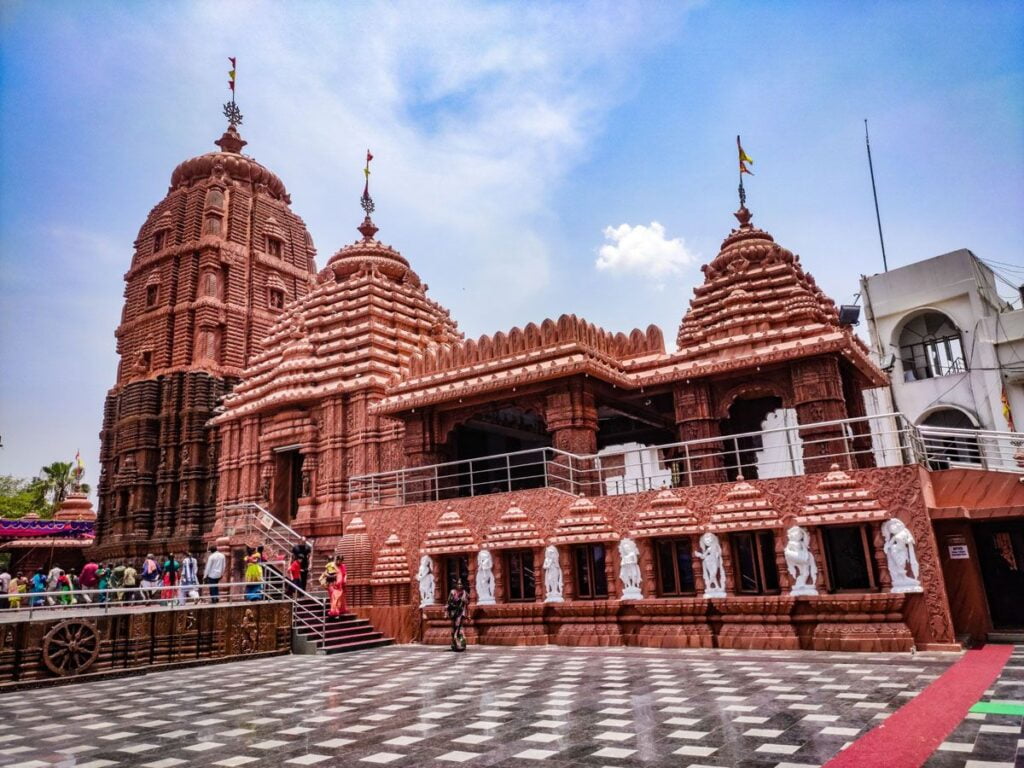
Contents
History of Jagannath Temple Hyderabad:
Conception (1992): The idea for the temple was conceived in 1992 by a group of Odia people residing in Hyderabad. Driven by their deep reverence for Lord Jagannath, they envisioned a place to celebrate their faith and share it with the wider community.
Years of Preparation (1992-2004): The initial years were marked by fervent prayers, rituals like Homas and Yagnas, and Kirtans to invoke blessings for the temple’s construction. Despite their efforts, progress remained elusive.
Divine Intervention (2004): In 2004, a series of seemingly serendipitous events unfolded. Skilled artisans and sculptors arrived in Hyderabad, seemingly drawn by an invisible force. This was interpreted as a divine sign, and construction finally began.
Construction and Completion (2004-2009): Over five years, more than 100 dedicated workers toiled tirelessly. Using 600 tonnes of sandstone brought from Odisha, they meticulously crafted the temple, replicating the architectural style of the iconic Jagannath Temple in Puri.
Consecration and Beyond (2009-present): The magnificent temple was finally consecrated in March 2009. Since then, it has become a vibrant center of Odia culture and a popular pilgrimage destination for devotees from across Hyderabad and beyond.
Read More>> 2000 yrs Om Shakthi Temple Melmaruvathur
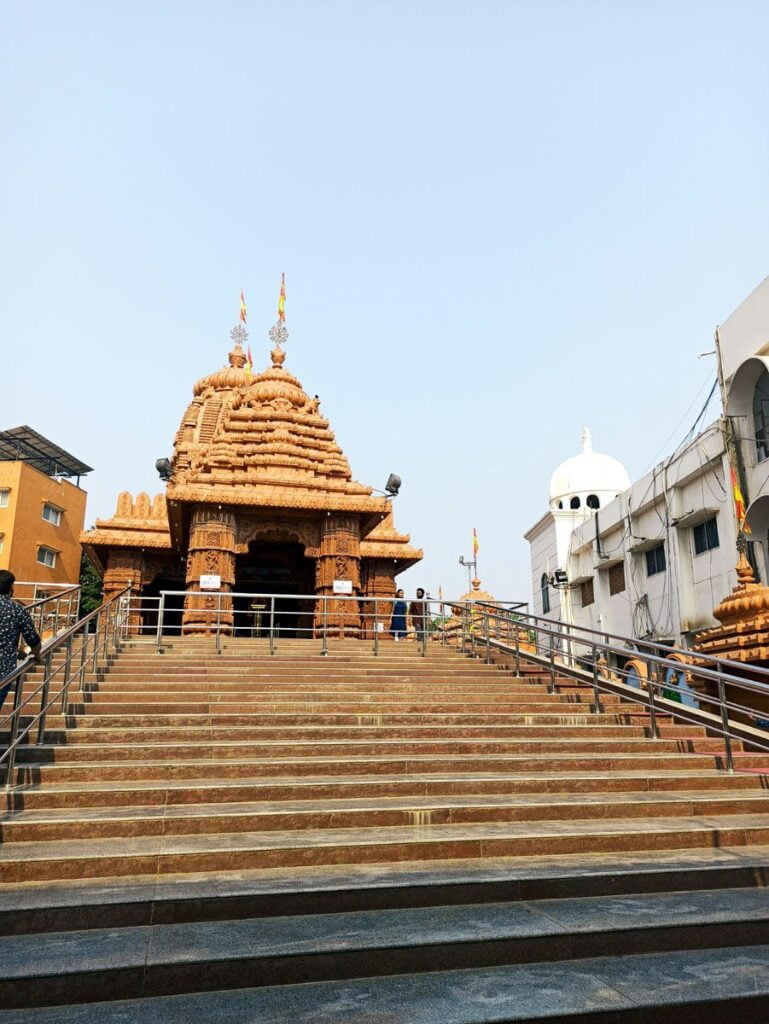
Architecture of Jagannath Temple Hyderabad:
The Jagannath Temple in Hyderabad, India, is a modern marvel inspired by its namesake in Puri, Odisha. Standing tall at 72 feet (compared to the original’s 214 feet), it’s a stunning monument to the Odia community’s devotion to Lord Jagannath, meaning “Lord of the Universe.”
A Replica with its own Charm:
- Orissan Style: Built between 2004 and 2009, the temple faithfully echoes the Kalinga architectural style of the Puri Jagannath Temple. Think curvilinear towers, pyramidal roofs rising in steps, and intricate stone carvings.
- Red Sandstone Splendor: The use of 600 tons of red sandstone brought from Odisha gives the temple its warm, inviting glow. Over 60 skilled stone carvers meticulously adorned the exterior with mythological scenes and celestial motifs.
- Sanctum Sanctorum: The heart of the temple houses the holy trinity of Lord Jagannath, his brother Balabhadra, and sister Subhadra, carved from neem wood just like the Puri deities.
Beyond the Main Deity:
- Upa-Devalayams: Surrounding the main temple are smaller shrines dedicated to other deities like Lord Shiva (Kasi Viswanath), Lord Ganesh, Maa Vimala, Maa Laxmi, Shree Anjaneya Swamy, and the Navagrahas.
- Nilachakra: Crowning the main tower is the Nilachakra, an eight-spoked wheel of Vishnu made from Ashtadhatu, an eight-metal alloy considered sacred.
- Dancing Hall: The Nata Mandir, or dancing hall, is a vibrant space where devotees gather for devotional songs and dances, especially during the annual Rath Yatra festival.
A Blend of Tradition and Modernity:
- Building Materials: While staying true to the traditional style, the Hyderabad temple incorporates modern materials like cement and brick for stability and longevity.
- Accessibility: Unlike the Puri temple’s steep steps, the Hyderabad Jagannath Temple features ramps and elevators, making it accessible to everyone.
Read More>> Skandagiri Temple of Sri Subrahmanya Swamy
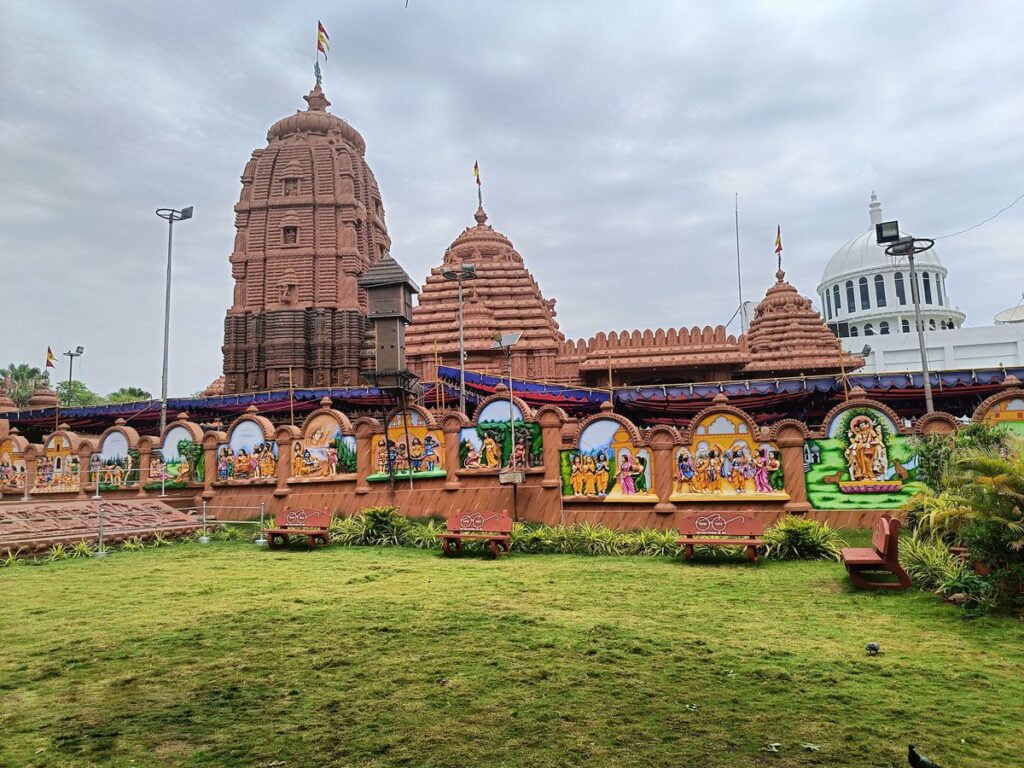
Significance of Jagannath Temple Hyderabad:
Religious Significance:
- Devotion to Lord Jagannath: Dedicated to Lord Jagannath, the temple serves as a focal point for Odia community residing in Hyderabad and other devotees who revere him as the “Lord of the Universe.”
- Replica of Puri Temple: Built as a replica of the iconic Jagannath Temple in Puri, Odisha, it carries the essence and traditions associated with the original shrine, allowing devotees to experience similar spiritual fervor.
- Sanctity and inclusivity: The temple strictly adheres to principles of sanctity, equity, discipline, and cleanliness, creating a welcoming space for people of all faiths and backgrounds to seek spiritual solace.
Cultural Significance:
- Preserving Odia heritage: The temple acts as a bridge between the Odia community in Hyderabad and their cultural roots. Rituals, festivals, and art forms like Odissi dance are celebrated here, fostering a sense of community and preserving traditions.
- Celebrating festivals: The annual Rathyatra festival, where three majestic chariots carrying the deities are paraded through the streets, is a major highlight, attracting thousands of devotees and tourists.
- Architectural marvel: The temple’s intricate carvings, sculptures, and vibrant red sandstone structure showcase the architectural finesse of Odisha, leaving visitors awestruck.
Social Significance:
- Promoting unity and harmony: The temple serves as a platform for people of different cultures and backgrounds to come together, fostering interfaith understanding and social harmony.
- Charitable activities: The temple trust is actively involved in various charitable initiatives, supporting the underprivileged and contributing to the social well-being of the community.
Read More>> Parthasarathy Temple Chennai
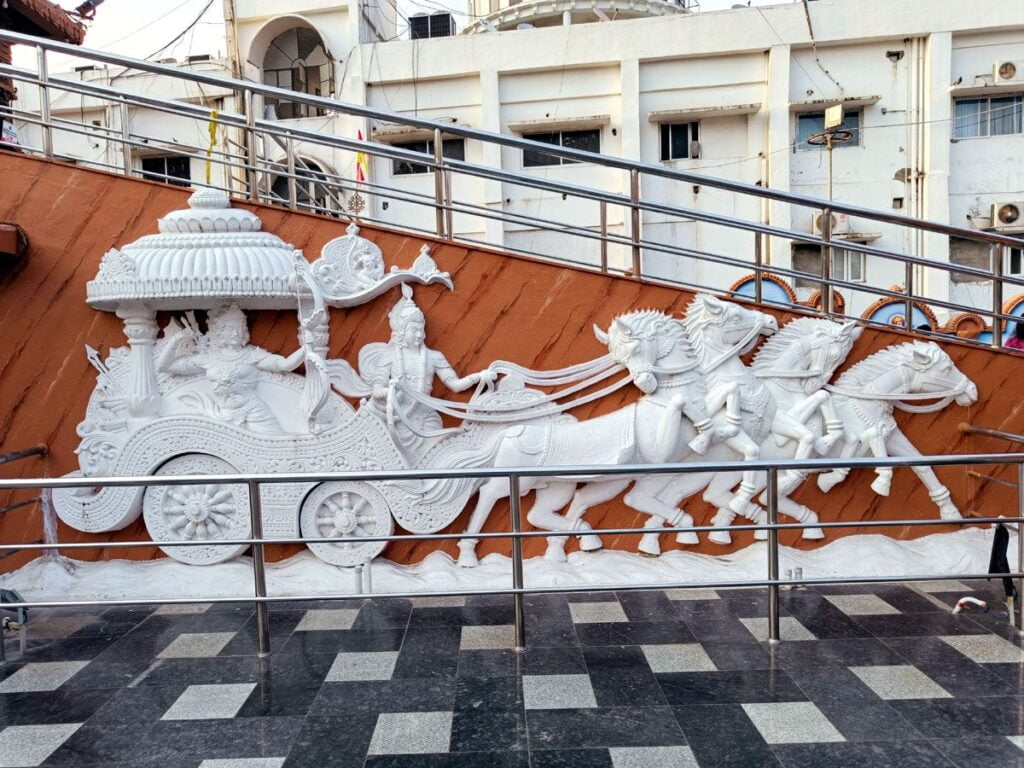
Timing and Rituals of Jagannath Temple Hyderabad:
Temple Timings:
- Morning: 6:00 AM to 12:00 PM
- Evening: 5:00 PM to 9:00 PM (10:00 PM on special occasions)
Important Rituals:
- Mangala Aarti: Performed at 6:00 AM, marking the first worship of the day for the deities.
- Abakash: Begins at 6:30 AM and involves waking up the deities and offering them Tulsi water.
- Mailam: 6:45 AM onwards, the deities are bathed with sacred water and fragrant oils.
- Sahanamela: 7:00 AM to 8:00 AM, the deities are dressed in their morning attire and offered breakfast prasad (Sakala Dhupa).
- Rosha Homa Surya Puja: 8:00 AM to 8:30 AM, a fire sacrifice and prayer to the Sun God is performed.
- Gopala Ballava Puja: 9:00 AM, a special puja dedicated to Lord Krishna as Gopala.
- Madhyanha Dhupa (Noon Offering): 11:00 AM to 1:00 PM, the deities are offered lunch prasad.
- Madhyanha Pahudha: 1:00 PM to 1:30 PM, the deities rest after their meal.
- Sandhya Aarati: 6:30 PM to 8:00 PM, evening worship with offerings and hymns.
- Badashringara Besha: 9:00 PM to 10:00 PM, the deities are adorned with elaborate ornaments and floral decorations for the night.
- Khata Seja Lagi and Pahuda: Around 12:00 AM, the deities are put to sleep in their respective chambers.
Read More>> Mayapur Temple of the Vedic Planetarium
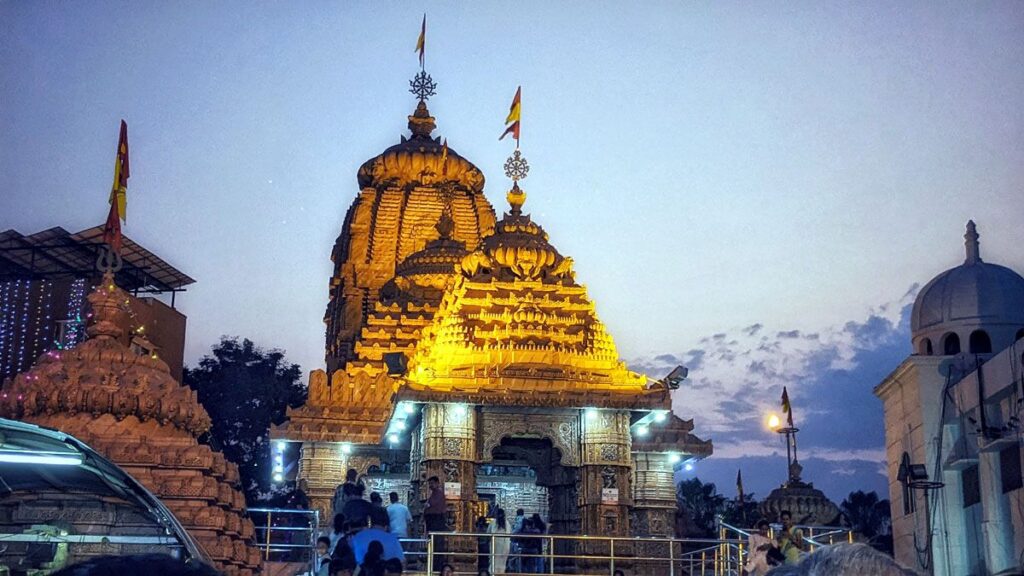
Places to visit near Jagannath Temple Hyderabad:
- Birla Mandir: A beautiful Hindu temple made of white marble, situated on a hill, offering panoramic views of the city.
- Charminar: One of the iconic landmarks of Hyderabad, Charminar is a historical monument and mosque with four grand arches.
- Golkonda Fort: A historic fort known for its acoustics, palaces, and the famous Fateh Rahben cannon.
- Qutub Shahi Tombs: The tombs of the Qutub Shahi rulers, displaying a blend of Persian and Indian architectural styles.
- Chowmohallah Palace: A palace of the Nizams showcasing their opulent lifestyle with grand halls, courtyards, and a vintage car collection.
- Salar Jung Museum: Home to a vast collection of art, artifacts, and antiques from around the world.
- Mecca Masjid: One of the largest mosques in India, known for its massive arches and a sacred atmosphere.
- Lumbini Park: A peaceful park located along the Hussain Sagar Lake, offering boat rides and a great view of the city.
- Nehru Zoological Park: A large zoo with a variety of species and an option for a safari tour.
- Shilparamam: A crafts village that showcases traditional arts, crafts, and cultural performances.

FAQ:
1. What is the Jagannath Temple Hyderabad?
The Jagannath Temple in Hyderabad is a modern Hindu temple dedicated to Lord Jagannath, meaning “Lord of the Universe.” Built by the Odia community in 2009, the temple is located on Road No. 12 in Banjara Hills and is known for its striking resemblance to the original Jagannath Temple in Puri, Odisha.
2. What are the architectural features of the temple?
The Jagannath Temple Hyderabad is constructed in the traditional Odia style, using red sandstone brought from Odisha. The most striking feature is the 70-foot-tall shikhara (tower) that dominates the temple complex. The temple walls are adorned with intricate carvings depicting scenes from Hindu mythology.
3. Which deities are worshipped in the temple?
The main deity in the Jagannath Temple Hyderabad is Lord Jagannath, who is worshipped along with his siblings, Balabhadra and Subhadra. Other deities enshrined in the temple include Lakshmi, Shiva, Ganesha, Hanuman, and the Navagrahas.
4. What are the temple timings?
The Jagannath Temple Hyderabad is open to devotees from 6:00 AM to 11:00 AM and 5:00 PM to 9:00 PM.
5. Are there any special festivals celebrated at the temple?
The most important festival celebrated at the Jagannath Temple Hyderabad is the Rath Yatra, which takes place in June or July each year. During this festival, the idols of Lord Jagannath, Balabhadra, and Subhadra are placed on three chariots and pulled through the streets of Hyderabad in a grand procession.
6. Is there anything else I should know before visiting the temple?
Visitors to the Jagannath Temple Hyderabad are expected to dress modestly and remove their shoes before entering the temple complex. Photography is not allowed inside the temple.
Here are some additional facts about the Jagannath Temple Hyderabad:
- The temple was built by the Kalinga Cultural Trust, a non-profit organization dedicated to promoting Odia culture and heritage.
- Over 600 tons of sandstone were used in the construction of the temple.
- Around 60 stone carvers from Odisha worked on the temple’s intricate carvings.
- The temple is a popular tourist destination and attracts thousands of visitors each year.
7. Is there an entry fee?
No, there is no entry fee to visit the temple.
8. What is the Rath Yatra festival?
The Rath Yatra is an annual festival celebrated in June or July. During this festival, the idols of Lord Jagannath, Balabhadra, and Subhadra are taken out of the temple in three elaborately decorated chariots and pulled through the streets of Hyderabad.
9. When to visit Jagannath Temple Hyderabad?
For spiritual atmosphere and darshan:
- Early mornings (6:00 AM – 8:00 AM): Enjoy a peaceful and serene visit with fewer crowds. This is a good time for darshan and meditation.
- Weekdays: Generally less crowded than weekends, especially mornings.
For festivals and vibrant experience:
- Rath Yatra festival (June or July): Witness the grand procession of decorated chariots and immerse yourself in the festive spirit. However, expect large crowds and potential travel congestion.
- Janmashtami (late August or early September): Celebrate the birthday of Lord Krishna with special pujas and programs.
- Other Hindu festivals: Diwali, Maha Shivaratri, etc., offer unique experiences with specific decorations and rituals.
For pleasant weather and comfortable sightseeing:
- October to February: Hyderabad experiences mild temperatures during these winter months, making it pleasant for sightseeing and temple visits. However, December might see festive crowds around Christmas and New Year.
- Avoid summer months (March to May): The weather can be hot and humid, making it less enjoyable for temple visits.
How to reach Jagannath Temple Hyderabad:
- By Air: If you’re coming from another city or country, you’ll likely land at the Rajiv Gandhi International Airport in Hyderabad. Once you’ve landed, you can hire a taxi or use a ride-sharing service like Uber or Ola to reach the temple. The distance from the airport to the temple may vary depending on your starting point within the city, but it will give you an approximate idea.
- By Train: Hyderabad has three major railway stations: Secunderabad, Hyderabad, and Kacheguda. Depending on your origin, you can reach any of these stations and then take a taxi, auto-rickshaw, or bus to the Jagannath Temple. The distance from these stations to the temple can vary, so it’s advisable to check the exact location and plan accordingly.
- By Road: If you are already in Hyderabad, you can use local transportation options such as buses, taxis, or auto-rickshaws to reach the temple. You can also use navigation apps like Google Maps to guide you to the temple’s location.
